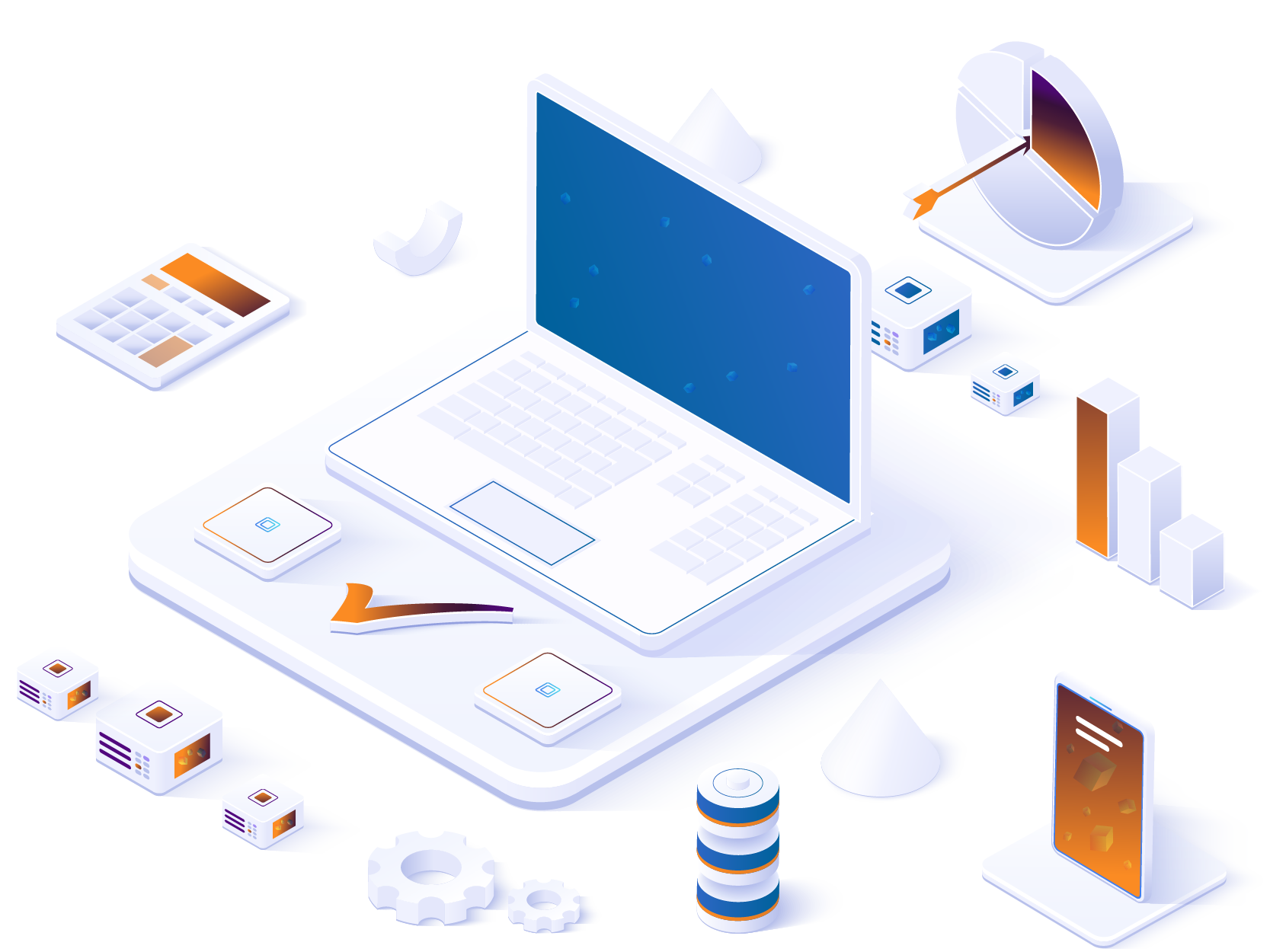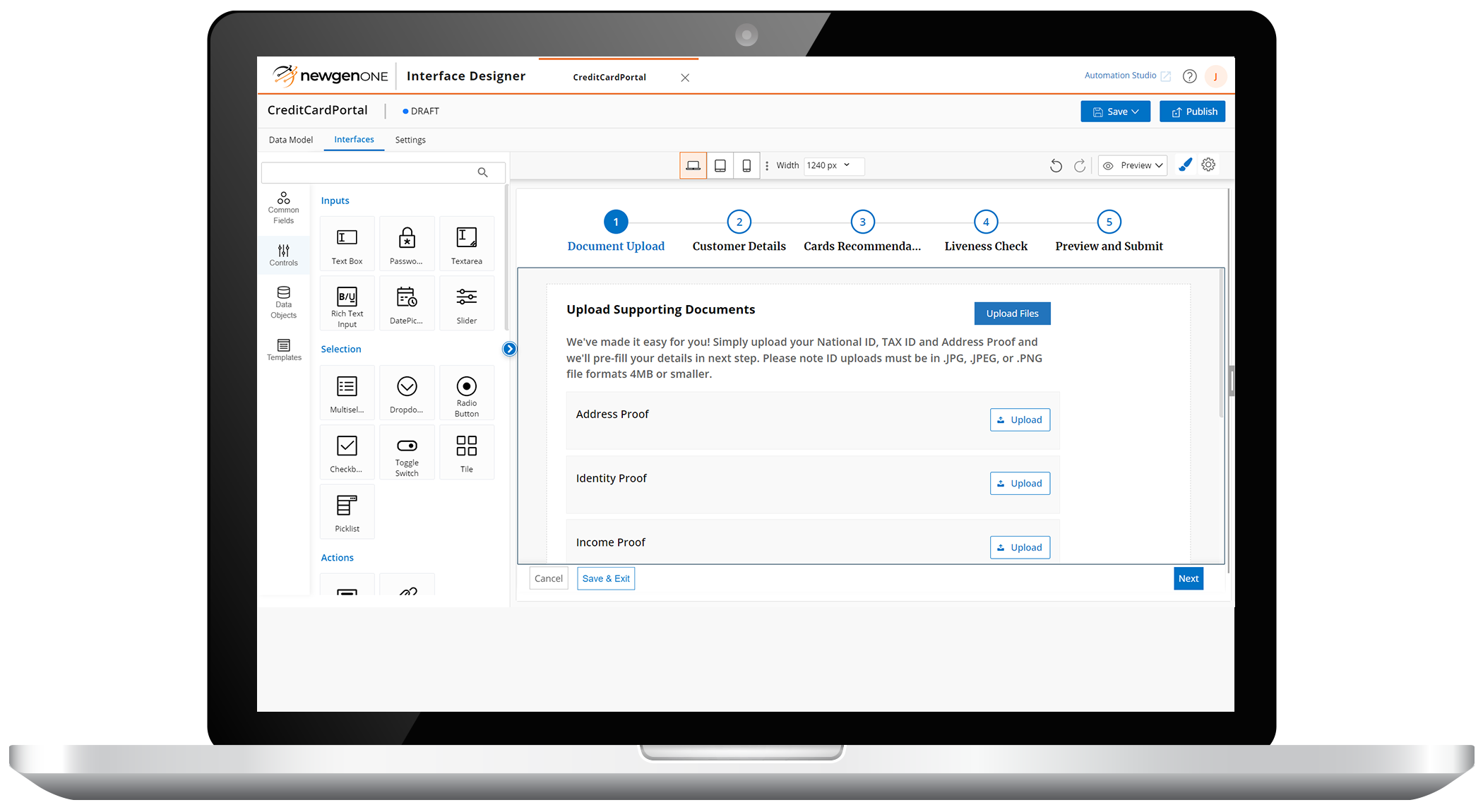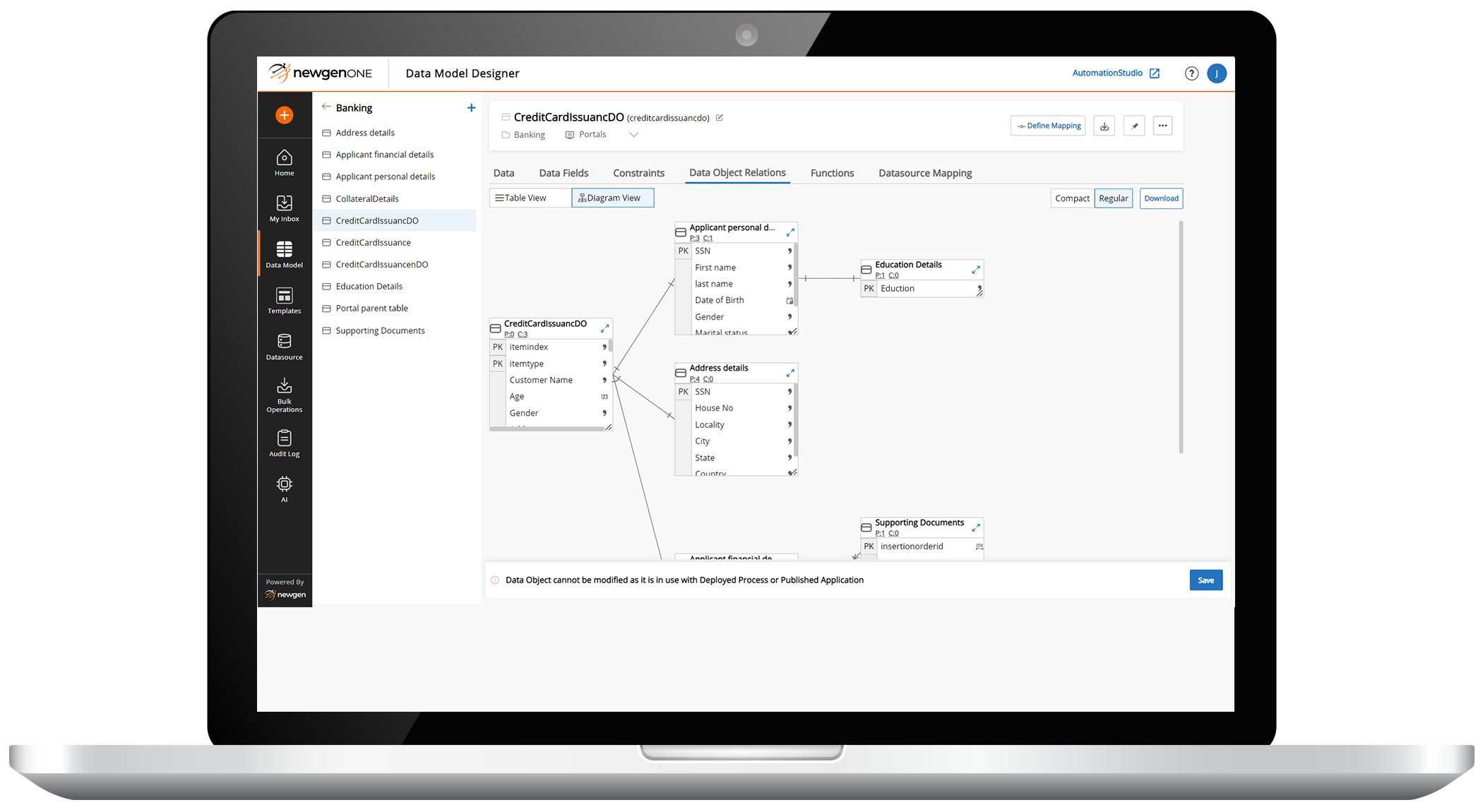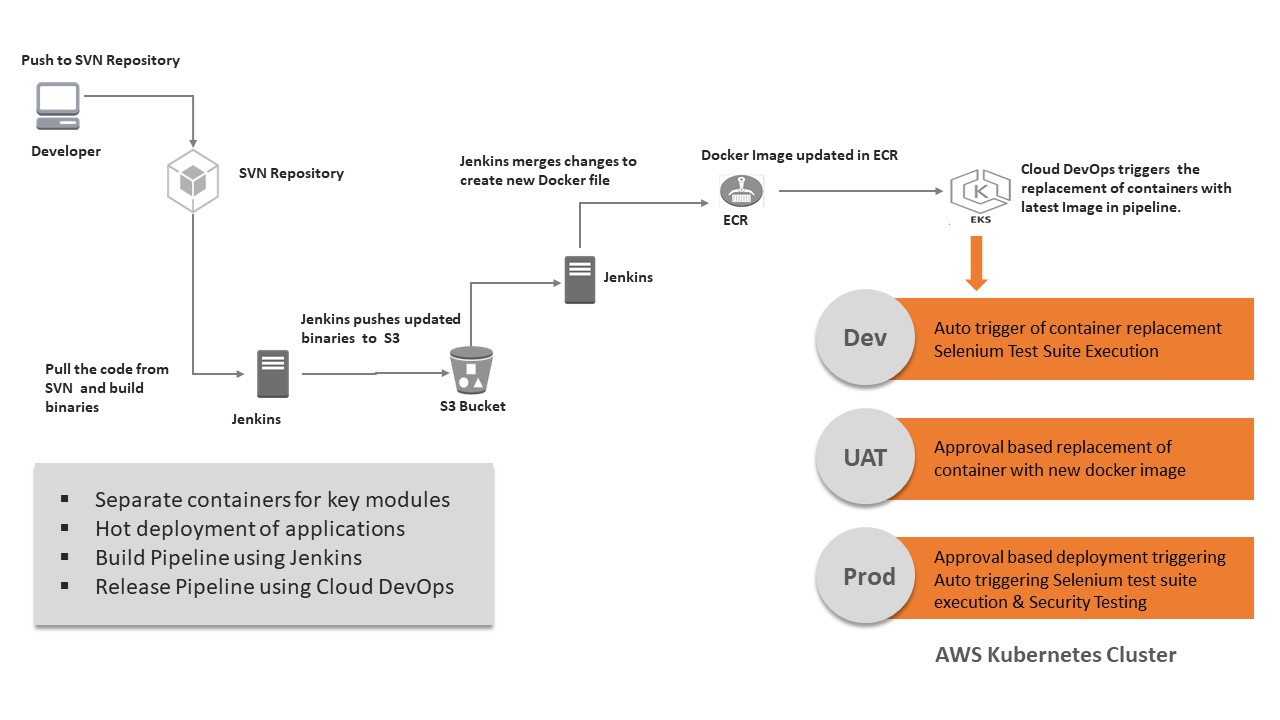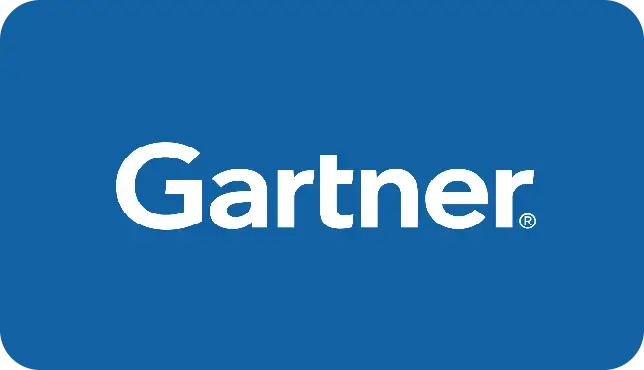Automate all types of business applications through a uniquely powerful low code capability across process, content, communication and AI. Rapidly compose complex mission-critical applications with enterprise-grade sturdiness and built-in agility for change. Low-Code Application Development platform transforms your enterprise with speed through end-to-end automation of thousands of applications and processes across the organization.
With Low Code Application Development, You Can Do It All
Low Code Application Development Capabilities of NewgenONE Platform
Lead with an Industry-recognized Platform
Low-code is a visual approach to software development that requires little to no coding to build applications and processes. This approach helps develop end-to-end applications rapidly with minimal coding to free your IT staff to focus on more value-add tasks. Furthermore, it helps in empowering citizen developers and reducing reliance on IT professionals.
Low-code is a next-gen rapid application development tool for multiple developers, whereas no code is a self-service application for business users. The primary purpose of low code is the speed of development it offers, whereas, for no-code, it’s the ease of use.
A low code development environment empowers multiple developer personas to develop applications using visual development tools. Developers can easily drag and drop application components to create mobile and web applications.
A low code application development platform is a visual software development environment that empowers multiple developer personas. It uses visual development tools with drag and drop or point and click design capabilities which abstract the code involved in application design and development, thereby providing a simple and intuitive development environment. It can help enterprises rapidly respond to evolving business needs and roll out applications with a shorter time to market.
Low code platform allows you to work with reusable components and drag-and-drop tools which can help reduce application development duration. This enables enterprises to involve all the stakeholders in the development lifecycle to quickly bring their applications to market and promptly incorporate any required changes.
Following are the benefits of using low code application development platform:
Customer satisfaction: Customers have become tech-savvy and want their vendors to respond promptly to their growing needs. Low code platform helps in such a scenario by allowing organizations to rapidly adapt to the evolving needs of the customer and changing markets.
Enable IT for mission-critical tasks: IT teams are burdened with many mundane tasks, such as system maintenance, compliance checks, and performance measurements. These recurring tasks can be automated through low code capabilities, empowering your IT team to handle more critical and dynamic processes.
Faster time to market: Low code platform allows you to work with reusable components and drag-and-drop tools which can help reduce application development duration. This enables enterprises to involve all the stakeholders in the development lifecycle to quickly bring their applications to market and promptly incorporate any required changes.
Enhance IT governance: Shadow IT is one of the most significant areas of concern and can result in sensitive data leaks for enterprises. Low-code platforms can handle shadow IT by reducing dependency on third-party applications. Low code boosts IT governance by ensuring a collaboration-driven work environment.
Following are the use cases of low code application development platform:
- Content-driven workflow applications: Low code platforms can enable businesses to automate their end-to-end content-centric processes/applications–such as customer onboarding, claims processing, and online account opening–ensuring that the right content is available at the right time to the right people at appropriate stages of the process.
- Mobile app development: Businesses can rapidly design and develop responsive mobile applications with point-and-click and drag-and-drop functionalities in a well-abstracted low code application development platform.
- Customer-facing and customer support portals: With low code, an organization can develop customer-facing portals such as customer self-service or agent portals that can easily be integrated with existing systems. Businesses can also leverage a template-based user interface development interface to design these portals for faster, simpler, and more efficient ways of interacting with the customer in real-time.
- Modernization of legacy systems: Low code can help enterprises extend their legacy systems. By leveraging the low code application development platform, businesses can support core systems and develop applications that can easily integrate into the existing system.
No, the low code approach is not meant to replace developers. The low code platform empowers multiple IT developers and fusion teams to enable rapid application development, thus giving them time to focus on more value-add tasks.
The NewgenONE Platform enables developers to register and export various application components, including portals, forms, process models, business rules, and data models. It helps improve the speed and efficiency of development by allowing other developers to reuse these components.
The platform also supports the cataloging of applications, making it easier for developers to reuse the complete solutions. It also lets users control the catalog access and share them selectively with other users.
An enterprise agile planning tool helps manage large-scale agile projects involving multiple teams, stakeholders, and complex workflows. JIRA is a widely used project management tool with built-in agile planning features. The NewgenONE Platform integrates seamlessly with JIRA and allows users to map platform projects with JIRA projects. It enables users to view their JIRA tasks on the platform and move the tasks per the board configurations.
Newgen offers a web-based integrated development environment (IDE) with visual development capabilities for citizen and professional developers. The NewgenONE Platform’s Automation Studio serves as an IDE that allows administrators to govern the tools used by different developer personas like application designer, process designer, data modeler, business rules designer, communication designer, and others.
NewgenONE’s web IDE integrates with various tools and services, such as version control systems, debugging tools, and testing frameworks. Furthermore,Newgen provides plug-ins for third-party IDEs such as Eclipse, and Visual Studio to enable customization and extensive functionalities.
NewgenONE Platform is built on the most widely used programming language frameworks. This makes it easier for the developers to extend the applications beyond the Out-of-the-box(OOTB) capabilities provided by the platform. For front-end users, it uses Java, JavaScript, Bootstrap, AngularJS, and ReactJS.
The platform uses a mobile application development framework backed with HTML, CSS, and JavaScript to deliver hybrid mobile applications. It wraps the HTML/JavaScript application into a native container that can access the device functions of several platforms. The platform also uses Python as an underlying language to create and train AI/ML models.
NewgenONE provides a web application development framework for building web portals and applications that are visible to end users. With a single click of a button, any web app developed on this platform can be extended as a Progressive Web App (PWA). Users can configure the details required to render a web app as a progressive web app, such as the app icon, display name, notification server details, and so on.
The platform includes drag-and-drop interfaces and pre-built components for quickly and easily creating web applications without needing to write a lot of code.
Enabling an application as a PWA makes it simple to design and deliver a consistent user experience regardless of the device used, whether mobile, desktop, or tablet. This enables organizations to maintain a single infrastructure for running web applications across multiple devices without the need for app store registration.
Newgen’s low code platform commits to an uptime of up to 99.95%. This uptime commitment ensures the high availability and reliability of Newgen’s low code platform, thereby empowering users with a stable and consistent experience accompanied by minimal disruptions and efficient use of the platform’s capabilities.
Yes, Newgen’s low code platform does support Application Program Interface-based integration. The platform supports both Representational state transfer (REST) and Simple Object Access Protocol (SOAP) APIs, thereby allowing for seamless integration with other systems and applications. This enables developers and users to leverage Newgen’s low code platform by integrating it with various external services, systems, and data sources using industry-standard API protocols. The support for API integration enhances the flexibility and interoperability of the Newgen low code platform, making it easier for users to connect and exchange data with external systems, streamline workflows, and build comprehensive, end-to-end solutions.
Newgen’s interface designer provides form building capabilities with WYSIWYG (What You See Is What You Get) design features. Users can easily create responsive forms by dragging and dropping form controls from the toolbox, resulting in visually appealing and interactive forms that ensure efficient data collection and an enhanced user experience.
The platform allows the reuse of forms across various devices, due to their responsiveness and adaptability to different form factors, including mobile, desktop, and tablet. This flexibility empowers users to seamlessly render the forms on any device, thereby enhancing accessibility and user experience.
Yes, Newgen’s low code platform facilitates the development of applications that use 2FA (Two-Factor Authentication). This security feature adds an additional layer of security by having users submit two forms of authentication. These are often a combination of something they know (such as a password) and something they have (such as a verification number they received on their mobile device). By implementing 2FA, Newgen’s low code platform helps improve security and protect sensitive data.
Yes, Newgen’s low code platform allows you to create responsive web applications. The platform is intended to let developers create web apps that adapt and customize their appearance, content, and functionality across various devices and screen sizes. Applications designed using Newgen’s low code platform provide a consistent and optimized user experience whether viewed on desktops, laptops, tablets, or mobile devices, by utilizing responsive design concepts. This adaptability ensures that the application’s interface and functions are easily accessible and visually appealing, improving usability and user satisfaction.
Yes, Newgen’s low code platform facilitates the development of progressive web applications. Developers can use Newgen’s low code platform to create Progressive Web Apps (PWAs) that are accessible via a web browser and include features like offline capability, push notifications, and device hardware access.
PWAs, created with Newgen’s low code platform, deliver a consistent and compelling user experience across devices and operating systems, thereby helping improve performance, accessibility, and user engagement.
